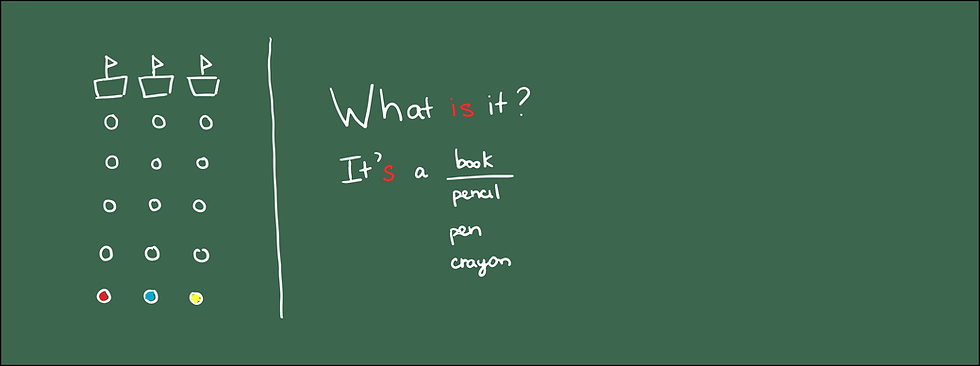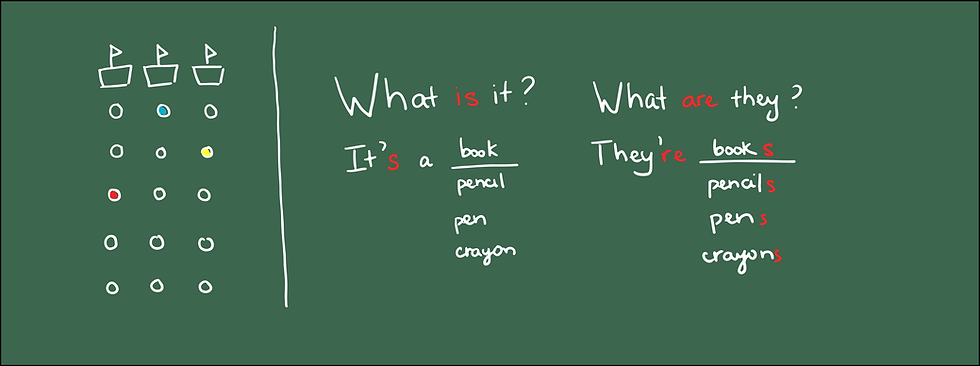The importance of Board Work
- IEG Consulting
- May 7, 2020
- 3 min read
Updated: Jun 22, 2020

“Have you planned on how you are going to organize your blackboard/whiteboard?”
Whenever asking new teachers this question, we most likely received blank stares. Fresh teachers do not usually think of planning the board when they plan the lesson.
Board work is such a powerful tool to enhance learning especially for primary/secondary students, yet teachers do not use them strategically enough. The necessity of board work stems from different research related to varied learning styles and brain development. In neuroscience, our brain is mainly an image processor because much of our sensory cortex is reserved for vision (Kouyoumdjian, 2012). The cognitive theory of multimedia learning by Mayer states that people learn more deeply from words and pictures than from words alone. Yet, the upper the grade, the less integration of visuals the teacher uses, and it might hinder children learning process. Hence, it is the time to pay much deserved attention to your board work regarding how you divide the board spatially as well as present the content chronologically.
Let’s start with the most basic tips on how to improve teachers’ board work.
First of all, think about the spatial structure of a board.
Start with dividing the board into sections including a permanent section and a temporary section. The permanent section can include components such as a behavior management system, objectives of the lesson to be ticked off, and target language of the lesson e.g. a grammar structure or vocabulary. The temporary section is devoted for parts of the lesson that can be cleaned off and re-used. (See Exhibit 1)
Exhibit 1: The permanent section (left) is the behavior management system. The temporary section (right) is devoted for examples. Teachers can use colored chalk to highlight parts that are important.

Think about the chronological order of your content.
When aligned with teaching, boarding content can also be scaffolding. Teacher starts with the foundation and keeps adding on information on the board when moving on to a new activity without erasing the previously boarded content. (See Exhibit 2)
Exhibit 2: Teachers can add a new grammar point “What are they?” without cleaning the previous point “What is it?” to help students compare the new structure to the foundation one. Teachers can use colored chalk to highlight parts that are important.Exhibit 2: Teachers can add a new grammar point “What are they?” without cleaning the previous points “What is it?” to help students compare the new structure to the foundation one. Teachers can use colored chalk to highlight parts that are important.

Next, think about colors and size.
Students, particularly young learners are attracted to colors and fonts. Use colors to emphasize parts you want students to pay attention to. For example, if you want your kids to notice singular form, you can use colored chalks to board the structure like so: “What is it? It’s a ball.” In addition, font in regards to capital or lower-case, bold or light can catch the attention of the students and implicitly teach students the hierarchy of the information. (See Exhibit 1 & 2)
Finally, make your board interactive.
Use it to play games with your class. Have students come to the board to draw, write, and even work. (See Exhibit 3)
Exhibit 3: Upon the foundation grammar points, teacher can have student play an interactive game on the board. In this game, this teacher draws two circles under two grammar structures. When the teacher brings up a flashcard, students will compete to tap on the circle that represents the correct answer and says it out loud.

Bear in mind, you are the person who will model for your students. How you use the board will be reflected in your students’ notebooks and affect the notetaking skill of students in a more logical way in the future.





Reading your post on the importance of board work really took me back to my early academic days, when I struggled to see the bigger picture in group projects and meetings, often feeling overwhelmed by deadlines, confusion, and unclear goals. Now, as a PhD student who also works part-time assisting others with buy assignment UK support at Affordable Assignments, I’m very conscious about both my studies and the wellbeing of the students I help, because I suffered a lot from those hustles in my college days trying to juggle workloads without much guidance. What you’ve shared reminds me how invaluable clear structure, collaborative thinking, and purposeful discussion can be, whether in organisational settings or in academic work, and how much it matters…
Сижу я, значит, дома, третий день после дембеля, форма ещё в шкафу висит, а я уже в трениках и с телефоном в руках. Всё надоело — ни работы нормальной, ни денег, только выплата за службу на карточке жалобно звенит. И вот листаю я ленту, а там реклама выскакивает: яркая, с барабанами, огоньками. Подумал — ладно, зайду, посмотрю, что за лучшее онлайн казино такое, вдруг хоть посмеюсь. Зарегистрировался за минуту, кинул тысячу рублей из дембельских — думал, солью и забуду.
Сначала, конечно, всё по классике. Кручу слоты — ноль. Ставлю на рулетку — ноль. Даже в блэкджек умудрился продуть три руки подряд. Сижу, матерюсь тихо, чтобы мама на кухне не услышала. Думаю: ну всё, Сёга, ты и в армии не научился…
Balancing coursework and technical projects can be stressful, but Rapid Assignment Help UK makes it much easier. I’ve used their Help With Assignments service for multiple subjects and always received professional, timely assistance. When it came to coding and simulations, their MATLAB Assignment Help gave me exactly what I needed — precise results, properly structured code, and in-depth understanding of the applied methods.